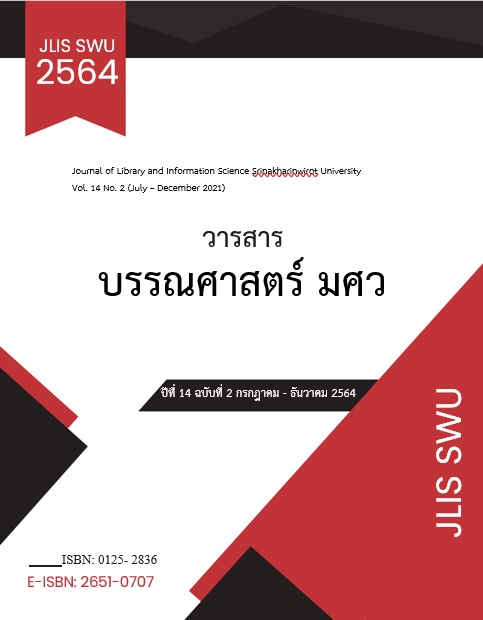AN ANALYSIS OF THE NEEDS OF PERSONS WITH CHINESE PROFICIENCY IN THAI LABOR MARKET THROUGH ONLINE INFORMATION
Keywords:
Needs, Person, Chinese, Thai Labor Market, Online InformationAbstract
The objectives of this research are to analyze the basic qualifications of job applicants who are proficient in Chinese in Thai labor market; to analyze the needs of persons who are proficient in Chinese in Thai labor market by classifying them into industry groups, functional areas and scope of duties of job applicants; to guide the design of curriculum, teaching and learning in subjects related to business Chinese. This research’s study is based on the information of persons with Chinese proficiency recruitment through 5 popular online job information in Thailand, totaling 519 announcements, uses the checklist tool and analyzes the data by using SPSS Statistics program. The results of the research showed that job applicants who had Thai citizenship, aged between 21 and 31, earned bachelor’s degree, and had no working experience were the most in-demand qualifications for the recruitment in the Thai labor market. The service business and industrial products business had the highest demand for the persons with Chinese proficiency, especially the interpreters/translators, administrators/ coordinators, and sales. Although the scope of duties of personnel in each line of work is different, coordinating, preparing documents, and translating documents are all considerable functions in each profession. In the aspect of language skills, each profession may have the most emphasis on one skill, nevertheless, listening, speaking, reading and writing skills are essential skills for communication. Moreover, the Chinese Proficiency Test (HSK Level 5), the abilities of media, technology and basic computer programs are capabilities that candidates should have in order to be ready for work in the 21st century. Therefore, the guidelines for the subjects related to business Chinese should be concerned curriculum development, instructional design and emphasis on skills during learning of the Chinese learners, to modernize and in accordance with the needs of the Thai labor market.
References
Chokdeemeesuk, K. (2015). The preparation of Chinese language to be ready for ASEAN community. HCU Journal of Health Science, 19 (37), 159. [in Thai]
Dan Shengjiang. (2012). ESP Teaching Research: Theory and Practice. Zhejiang University Press, 1688-1720.
Dudley-Evans, T., & St John, M. J. (1998). Developments in ESP: A multi-disciplinary
approach (No. 428.007 D849). Cambridge university press.
Hutchinson, T., Waters, A., & Swan, M. (1987). English for specific purposes. Cambridge
university press.
Jirapas, C. (2007). The potential of the Chinese language graduates and opinion on the development of the effective Chinese curriculum. Liberal Arts Review, 2 (3), 39-49. [in Thai]
Johns, A. (1991). English for specific purposes: its history and contribution. In Celce-Murcia, M. (Ed). Teaching English as a second or foreign language (pp.67-77). Boston, MA: Heinle & Heinle.
Poonlarp, T. (2016). Investigating the Needs for Interpreters in the Thai Labor Market through Online Job Advertisements. Journal of Letters, 45 (2), 263-303. [in Thai]
Reungrong, P., Jiravarapong, B., Manyum, W., Somyaron, W., Muendej, S., & Srisurat, C. (2014). Educational Technology Vs Thai Teachers in 21st Century. Panyapiwat Journal, 5, 195-207. [in Thai]
Sankaburanurak, S. (2017). Multimedia and Technologies for Teaching Chinese Language in 21st Century. Veridian E-Journal, Silpakorn University, 10 (3), 1239-1256. [in Thai]
Wasinanon, N. (2016). The Study of Thailand’s Systematic Chinese Teaching Management if Higher Education. Chinese Studies Journal, 9 (2), 263-287. [in Thai]
Watthanabut, B. (2021). Factors Affecting that Impact on Soft Skills Development of Thai Youth in 21st Century. The Journal of Research and Academics, 4 (1), 87-94. [in Thai]
Thai Commercial Bank. (2020). Focus on China's Investment in Thailand - Investment and Opportunities in Thailand after the Outbreak of Coronavirus Pneumonia Era. https://www.scb.co.th/content/dam/scb/china/investment-knowledge/eyes-on-china-inflow-to-thailand-2020-2021/%E6%96%B0%E5%86%A0%E8%82
%BA%E7%82%8E%E7%96%AB%E6%83% 85%E5%90%8E%E6%97%B6%E4%BB%A3%E7%9
A%84%E6%8A%95%E8%B5%84%E8%BF%9C%E8%A7%81%E5%92%8C%E6%9C%BA%E9%81%87.pdf?form=2 [in Chinese]
The Stock Exchange of Thailand. (2020). Classification of Industry Group and Sector.
https://www.set.or.th/en/regulations/simplified_regulations/industry_sector_p1.html
Additional Files
Published
Issue
Section
License
Copyright Notice
Copyright of articles in the journal of Journal of Library and Information Science Srinakharinwirot University is the author's and the Faculty of Humanities, Srinakharinwirot University. All articles submitted for publication will be assessed by a group of distinguished reviewers. The Faculty of Humanities, Srinakharinwirot University and the editorial board claim no responsibility for the contents or views expressed by the authors of Individual articles. Copying is allowed freely, provided acknowledgement is made thereof, and within the scope of copyright law.



